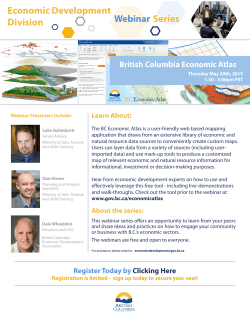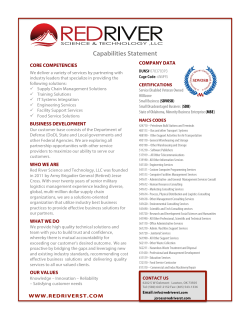
High Performance in Sprint Execution
Agile / Scrum Training | Lean Software Development | Agile Organizational Metrics | Executive Coaching | Improved Team Dynamics | Improved Efficiency High Performance in Sprint Execution #BecomingAgile Webinar Series Webinar Guidelines ¨ ¨ ¨ ¨ ¨ Presentation to last approximately 45 minutes All participant lines will be muted during the presentation At the conclusion of the presentation questions will be taken through the chat feature of WebEx Any unanswered questions will be captured and responses provided to attendees within 1 week Session is being recorded and will be posted for review THANK YOU FOR ATTENDING! #BecomingAgile Webinar Series – ©2015 Davisbase Consulting Today’s Presenter Agile Coach & Trainer Davisbase Consulting cody.meche@davisbase.com ¨ Trained over 1,500 practitioners ¨ Successfully coached dozens of teams ¨ CSP, PMI-ACP, SPC @davisbase! #BecomingAgile! #agile! Connect on LinkedIn: www.linkedin.com/in/codymeche/en #BecomingAgile Webinar Series – ©2015 Davisbase Consulting Today’s Topics 1. Characteristics of High Performing Teams 2. Observable Traits of Maturity in Sprint Execution 3. A 4-Level Maturity Model to Assess Performance #BecomingAgile Webinar Series – ©2015 Davisbase Consulting Excellence within the Sprint What do we look for? ¤ Consistent collaboration ¤ Swarming ¤ Accountability for commitments ¤ Proactive communication ¤ Engagement of stakeholders #BecomingAgile Webinar Series – ©2015 Davisbase Consulting Measuring Sprint Performance What it is not… ¤ Evaluation of metrics to game the system ¤ A command-and-control mechanism ¤ A way to compare good vs. bad teams ¤ The only thing that defines success #BecomingAgile Webinar Series – ©2015 Davisbase Consulting The Intent of Assessment Transparency Reflection Relentless Good Change (Kaizen) #BecomingAgile Webinar Series – ©2015 Davisbase Consulting Observable Maturity Levels 1 Teams new to Agile. Characteristics and traits of their activities and outcomes. 2 3 Teams that have been embracing Agile practices for 4-9 months. How their behaviors have advanced. Teams that have come into their own and are approaching the “Ri” state of the Shu, Ha, Ri journey. 4 #BecomingAgile Webinar Series – ©2015 Davisbase Consulting Teams that have achieved high levels of maturity and excellence with both their Agile practices and outcomes. 8 Dimensions for Evaluation Sprint Planning & Commitments Daily Planning & Accountability Customer Feedback & Acceptance Managing the Flow of Work Engineering & Development Practices Quality Assurance & Testing Prioritization & Sequencing #BecomingAgile Webinar Series – ©2015 Davisbase Consulting Scope & Expectations Management 8 Dimensions for Evaluation Sprint Planning & Commitments Daily Planning & Accountability Customer Feedback & Acceptance Managing the Flow of Work Engineering & Development Practices Quality Assurance & Testing Prioritization & Sequencing #BecomingAgile Webinar Series – ©2015 Davisbase Consulting Scope & Expectations Management Sprint Planning & Commitments 1 Paperclips are used to visualize capacity and estimates. Sprint planning may last upwards of 4-6 hours. 2 3 Teams plan tasks and estimate hours and track data electronically. The session may take 2-4 hours. Teams are able to discuss and identify tasks, but no longer need detailed hour estimates. Session duration has decreased to 1-3 hours. 4 #BecomingAgile Webinar Series – ©2015 Davisbase Consulting Through experience and collaboration, teams can commit based on discussion of backlog items alone. Sessions take less than 2 hours. Daily Planning & Accountability 1 The Daily session is often a report to the ScrumMaster and have little peer-to-peer interaction. Feels command-and-control. 2 3 Team Members talk to one another, but flow of the conversation is highly facilitated by the ScrumMaster. Daily commitments are made. Teams communicate seamlessly and naturally escalate impediments as well as hold one another accountable for commitments made. 4 #BecomingAgile Webinar Series – ©2015 Davisbase Consulting Teams hold the session whether or not a SM is there to remind them. Customer Feedback & Acceptance 1 Teams demonstrate the product at the Demo in order to gain acceptance. 2 3 Teams gain earlier acceptance during Sprint Review so that Demos are for a larger stakeholder set. Once all tasks complete for an item, the PO is engaged for early review and acceptance. 4 #BecomingAgile Webinar Series – ©2015 Davisbase Consulting Automated Acceptance Tests are written before the code, so acceptance is nearly automated. Managing the Flow of Work 1 Day 1 & 10 are separate days where little other work occurs. Team Members are only focused on tasks they signed up for in Planning. Lots of work is in progress at once. 2 3 The team is enforcing Story-Level WIP limits to gain efficiency, but team members rarely swarm and take on tasks outside of traditional responsibilities. The team is enforcing Task-Level WIP limits and assist others in resolving impediments in order to move things forward. 4 #BecomingAgile Webinar Series – ©2015 Davisbase Consulting The team has combined Day1/10 activities into a single calendar day, enforce task-level WIP limits and swarm to complete work efficiently and effectively. Engineering & Development Practices 1 Teams deploy code manually 1-3 times per sprint. 2 Teams build at least once a day. 3 Teams are able to build multiple times a day and have gated check-ins to assist with code quality. 4 #BecomingAgile Webinar Series – ©2015 Davisbase Consulting Teams have a full Continuous Integration processes with gated check-ins and deployments on-demand. Quality Assurance & Testing 1 Tests are written and executed within the sprint with little to no automation. Most testing activities occur in the last few days of the iteration. 2 3 Tests are written early (sometimes automated) within the sprint, but not necessarily before the code is written. Tests are understood before the sprint, but written and automated early in the sprint cadence (not necessarily before code is written). 4 #BecomingAgile Webinar Series – ©2015 Davisbase Consulting Tests are written before the sprint and serve as specifications and models for how the product should work. They are automated before the code is written. Prioritization & Sequencing 1 Decisions are often based on “gut feel” with little to no input from stakeholders across the organization. 2 3 Silo’d prioritization and sequencing occur for individuals teams, but dependencies are not aligned and strategic themes are not considered. Stakeholders across the portfolio are involved so that priorities and dependences are transparent and aligned. 4 #BecomingAgile Webinar Series – ©2015 Davisbase Consulting High-priority items represent a tightlyaligned MVP/MMF and are sequenced to minimize dependencies and maximize efficiency. Techniques like WSJF are used. Scope & Expectations Management 1 Teams target scope for a release through a release plan, but do not maintain backlog depth or a baselined release plan. 2 3 Teams baseline a release plan at the close of each iteration. Teams engage stakeholders in release planning activities to ensure input and support from the organization. Updates are made each iteration. 4 #BecomingAgile Webinar Series – ©2015 Davisbase Consulting Teams maintain integrated and aligned projections of work looking forward 4-5 sprints and update forecasts each iteration. Visualizing Team Maturity Cumulative Flow Cycle Time Average Velocity CvC #BecomingAgile Webinar Series – ©2015 Davisbase Consulting CvC (Complete vs. Commit) The ratio of # of points Completed versus the # of points committed to. Plotted on a line graph. #BecomingAgile Webinar Series – ©2015 Davisbase Consulting CvC (Complete vs. Commit) 110 100 90 110 80 100 70 90 60 80 50 70 40 60 30 50 20 40 10 30 20 10 #BecomingAgile Webinar Series – ©2015 Davisbase Consulting Cumulative Flow Visualization of the amount of work in each state of the process. Displayed using a Stacked Area chart. #BecomingAgile Webinar Series – ©2015 Davisbase Consulting Cumulative Flow #BecomingAgile Webinar Series – ©2015 Davisbase Consulting Average Velocity The number of points finished/ accepted each sprint. Plotted on a line graph. #BecomingAgile Webinar Series – ©2015 Davisbase Consulting Average Velocity 100 90 80 100 70 90 60 80 50 70 40 60 30 50 20 40 10 30 0 20 10 0 #BecomingAgile Webinar Series – ©2015 Davisbase Consulting Cycle Time The number of days it takes a backlog item to get from start to finish within the sprint. Plotted on a frequency diagram. #BecomingAgile Webinar Series – ©2015 Davisbase Consulting Cycle Time . . 1 2 . 3 4 5 6 . . . . . . . . . . . . . . 7 9 8 10 # Days to Finish a Backlog Item . . . . . . . . . . . . . . . . . . 1 4 2 3 5 6 7 8 9 10 # Days to Finish a Backlog Item #BecomingAgile Webinar Series – ©2015 Davisbase Consulting Wrapping Up High Performance in Sprint Execution www.davisbase.com | @davisbase |#BecomingAgile Your Call to Action Visualize and plan Shu, Ha, Ri transformation ¨ Commit to improving ¨ Inspect and adapt always! ¨ Share your success story ¨ #BecomingAgile Webinar Series – ©2015 Davisbase Consulting Learn More Online 4-Step Assessment Model Monthly Series ? 15 davisbase.com/blog #BecomingAgile Webinar Series – ©2015 Davisbase Consulting The Next #BecomingAgile Webinar Collaboration Techniques for Defining Backlog Items Thursday, April 2, 2015 12:00pm ET www.davisbase.com | @davisbase |#BecomingAgile Claim Your PMI PDUs • • • Self report your PDUs on PMI.org Provider/REP #4095 This event is worth 1 PDU www.davisbase.com | @davisbase |#BecomingAgile Thank You! STAY CONNECTED! www.davisbase.com 877-DAVIS-10 @davisbase Davisbase Consulting #BecomingAgile - Blog - Webinar Series - Newsletter Cody Meche cody.meche@davisbase.com #BecomingAgile Webinar Series – ©2015 Davisbase Consulting
© Copyright 2025








